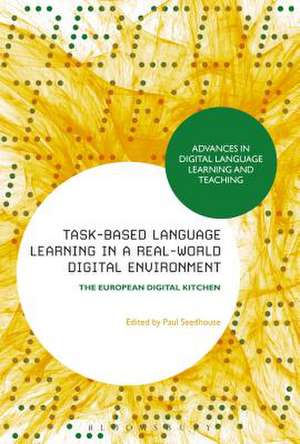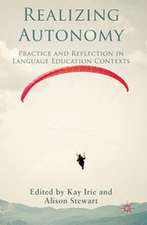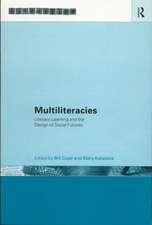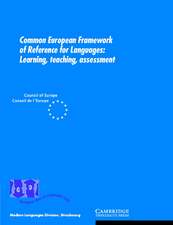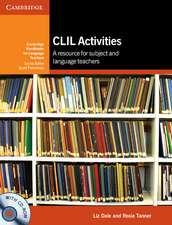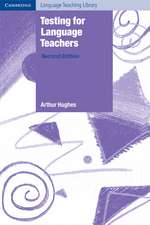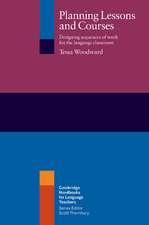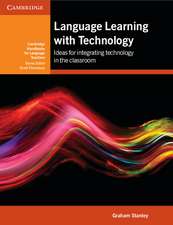Task-Based Language Learning in a Real-World Digital Environment: The European Digital Kitchen: Advances in Digital Language Learning and Teaching
Editat de Professor Paul Seedhouseen Limba Engleză Paperback – 22 aug 2018
| Toate formatele și edițiile | Preț | Express |
|---|---|---|
| Paperback (1) | 239.02 lei 6-8 săpt. | |
| Bloomsbury Publishing – 22 aug 2018 | 239.02 lei 6-8 săpt. | |
| Hardback (1) | 833.64 lei 6-8 săpt. | |
| Bloomsbury Publishing – 8 feb 2017 | 833.64 lei 6-8 săpt. |
Din seria Advances in Digital Language Learning and Teaching
- 23%
 Preț: 190.50 lei
Preț: 190.50 lei - 23%
 Preț: 192.36 lei
Preț: 192.36 lei - 23%
 Preț: 192.90 lei
Preț: 192.90 lei - 13%
 Preț: 257.59 lei
Preț: 257.59 lei - 13%
 Preț: 239.14 lei
Preț: 239.14 lei - 23%
 Preț: 229.68 lei
Preț: 229.68 lei - 22%
 Preț: 230.69 lei
Preț: 230.69 lei - 22%
 Preț: 260.07 lei
Preț: 260.07 lei - 22%
 Preț: 230.15 lei
Preț: 230.15 lei - 13%
 Preț: 257.50 lei
Preț: 257.50 lei - 23%
 Preț: 199.37 lei
Preț: 199.37 lei - 23%
 Preț: 192.36 lei
Preț: 192.36 lei - 30%
 Preț: 570.43 lei
Preț: 570.43 lei - 30%
 Preț: 569.94 lei
Preț: 569.94 lei - 30%
 Preț: 568.22 lei
Preț: 568.22 lei
Preț: 239.02 lei
Preț vechi: 306.42 lei
-22% Nou
Puncte Express: 359
Preț estimativ în valută:
45.74€ • 47.66$ • 37.87£
45.74€ • 47.66$ • 37.87£
Carte tipărită la comandă
Livrare economică 03-17 aprilie
Preluare comenzi: 021 569.72.76
Specificații
ISBN-13: 9781350082120
ISBN-10: 1350082120
Pagini: 304
Dimensiuni: 156 x 234 x 15 mm
Greutate: 0.43 kg
Ediția:NIPPOD
Editura: Bloomsbury Publishing
Colecția Bloomsbury Academic
Seria Advances in Digital Language Learning and Teaching
Locul publicării:London, United Kingdom
ISBN-10: 1350082120
Pagini: 304
Dimensiuni: 156 x 234 x 15 mm
Greutate: 0.43 kg
Ediția:NIPPOD
Editura: Bloomsbury Publishing
Colecția Bloomsbury Academic
Seria Advances in Digital Language Learning and Teaching
Locul publicării:London, United Kingdom
Caracteristici
The book provides in-depth empirical studies of how the digital kitchen system was implemented in 5 different European countries with 7 different languages and with a range of types of learners
Notă biografică
Paul Seedhouse is Professor of Educational and Applied Linguistics and School Research Director in the School of Education, Communication and Language Sciences, Newcastle University, UK. His monograph "The Interactional Architecture of the Language Classroom" (2004) won the Modern Languages Association of America Mildenberger Prize.
Cuprins
List of IllustrationsNotes on ContributorsAcknowledgementsTranscription ConventionsPART I: BACKGROUND1. Introduction, Paul Seedhouse (Newcastle University, UK)2. Locating the European Digital Kitchen in its research context, Sandra Morales Rios (Newcastle University, UK)PART II: DESIGN3. The Pedagogical Design of the Digital Kitchen, Paul Seedhouse (Newcastle University, UK)4. The Technology behind the Digital Kitchen for Language Learning, Paul Seedhouse (Newcastle University, UK)5. The Human Viewpoint and the System's Viewpoint, Gabriele Pallotti and Natacha Niemants. (University of Reggio Emilia, Italy)PART III: IMPLEMENTATION6. Assessing and promoting language development in an interactive learning environment, Jana Roos, Nina Reshöft, Lea Hartung and Johanna Bußwinkel (Paderborn University, Germany)7. Cooking, Interaction and Learning: the Finnish Digital Kitchen as a Language Learning Environment, Salla Kurhila and Lari Kotilainen (University of Helsinki, Finland)8. "The more I cook, the more I learn": Tracing Ava's Learning Itinerary through her Participation in Four Cooking Sessions, Dolors Masats, Marta Juanhuix and Javier Albines (Universtat Autonoma de Barcelona, Spain)9. Vocabulary Learning in a Real-World Digital Environment, Gabriele Pallotti, Natacha Niemants (University of Modena and Reggio Emilia, Italy) and Paul Seedhouse (Newcastle University, UK)10. Sight and Touch in Vocabulary Learning: The Korean Digital Kitchen, Jaeuk Park and Paul Seedhouse (Newcastle University, UK)PART IV: CONCLUSIONS11. Conclusions and Future Developments, Paul Seedhouse (Newcastle University, UK)Index
Recenzii
This volume offers a fascinating example of the meaningful introduction of technology into the language classroom to provide contextualized, real-world scenarios that, while being authentic, allow a team of two students to socially create a language experience together ... A worthy addition to language learning with technology, and a valuable resource for those who want to create a similar project.
Overall, the volume represents a valuable addition to project- and task-based research scholarship in digital settings ... Due to its innovative design and careful implementation research agenda, the volume offers insightful ideas and perspectives to those interested in using real spaces to afford foreign language learning.
The book presents a convincing argument for the digital kitchen concept and its expansion into new areas of study.
The European Digital Kitchen Project manages to bring pervasive computing practices into the realm of language learning by integrating the everyday task of cooking (with real-world equipment) with language and culture learning through tasks. The chapters in the book not only build a mosaic that helps understand how people engage in a digital sensory environment, they demonstrate that experiential learning in a digital environment provides opportunities for language learning (mainly for lexical items). The project and this book open an exciting research venue into digital sensor technology and how it can be applied for cultural and language learning beyond lexical development and into different environments.
This edited volume provides an innovative take on language and culture learning with technology in a unique context, the digital kitchen. It merges theories and concepts in human computer interaction, computer-assisted language learning, and task-based language teaching in the European digital kitchen to examine how ubiquitous and ambient technology, such as that found in our homes, can support language and culture learning through the cooking of national dishes.
An enjoyable initial interrogation.
A wonderful book that paints a bright future for how CALL and TBL can be combined in highly innovative ways.
Overall, the volume represents a valuable addition to project- and task-based research scholarship in digital settings ... Due to its innovative design and careful implementation research agenda, the volume offers insightful ideas and perspectives to those interested in using real spaces to afford foreign language learning.
The book presents a convincing argument for the digital kitchen concept and its expansion into new areas of study.
The European Digital Kitchen Project manages to bring pervasive computing practices into the realm of language learning by integrating the everyday task of cooking (with real-world equipment) with language and culture learning through tasks. The chapters in the book not only build a mosaic that helps understand how people engage in a digital sensory environment, they demonstrate that experiential learning in a digital environment provides opportunities for language learning (mainly for lexical items). The project and this book open an exciting research venue into digital sensor technology and how it can be applied for cultural and language learning beyond lexical development and into different environments.
This edited volume provides an innovative take on language and culture learning with technology in a unique context, the digital kitchen. It merges theories and concepts in human computer interaction, computer-assisted language learning, and task-based language teaching in the European digital kitchen to examine how ubiquitous and ambient technology, such as that found in our homes, can support language and culture learning through the cooking of national dishes.
An enjoyable initial interrogation.
A wonderful book that paints a bright future for how CALL and TBL can be combined in highly innovative ways.
